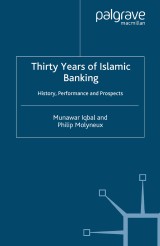Details

Thirty Years of Islamic Banking
History, Performance and ProspectsPalgrave Macmillan Studies in Banking and Financial Institutions
|
53,49 € |
|
| Verlag: | Palgrave Macmillan |
| Format: | |
| Veröffentl.: | 13.01.2016 |
| ISBN/EAN: | 9780230503229 |
| Sprache: | englisch |
| Anzahl Seiten: | 208 |
Dieses eBook enthält ein Wasserzeichen.
Beschreibungen
This text explains how Islamic banking works and what it offers as an alternative model of financial intermediation. Important questions addressed include: Why Islamic banking started and where it is going? Who are the main players at present and whom it will attract in future? What are its strengths and weaknesses? Will Islamic banks survive in highly competitive and globalized financial markets? What are their prospects and potentials? How does the relative performance and efficiency of Islamic banks compare to conventional banks?
List of Tables and Boxes Preface Glossary of Arabic Terms List of Abbreviations PART 1 : INTRODUCTION PART 2: THEORETICAL FOUNDATIONS OF ISLAMIC BANKING Why Islamic Banking: The Rationale Principles of Islamic Banking: The Basis Conclusion PART 3: DEVELOPMENT OF THE ISLAMIC BANKING MODEL What is Islamic Banking: The Model How is Islamic Banking Different from Conventional Banking: The Salient Features What does The Islamic Banking Model Promise? Conclusion PART 4: HISTORY AND GROWTH OF ISLAMIC BANKING AND FINANCE How Islamic Banking Started Various Manifestations of the Islamic Financial Industry Country Experiences with Islamic Banking Islamic Banks and Financial Institutions Working in Mixed Environments Islamic Banking Practices by Conventional Banks International Islamic Financial Institutions Other Institutions Conclusion PART 5: THE PERFORMANCE OF ISLAMIC BANKS Soundness Prudence Effectiveness Economy Profitability Islamic and Conventional Banks: A Comparative Analysis Conclusion PART 6: EFFICIENCY IN ISLAMIC BANKING Why Study Islamic Bank Efficiency? Measuring Bank Efficiency Empricial Evidence on Efficiency in Islamic Banking Conclusion PART 7: CHALLENGES FACING ISLAMIC BANKING Theoretical Challenges: Unresolved Issues Practical Challenges: Operational Problems Conclusion PART 8: ISLAMIC BANKING IN THE TWENTY-FIRST CENTURY Where Islamic Banking Needs To Go: The Way Ahead Conclusion PART 9: SOME AREAS FOR FURTHER RESEARCH IN ISLAMIC BANKING AND FINANCE Asymmetric Information Moral Hazard Problems Adverse Selection Problems Principal Agent Problems and the Need for Monitoring Implications of the Sharing Features of PLS Contracts The Need for Further Empirical Investigations Conclusion PART 10: SUMMARY AND CONCLUSIONS Bibliography Index Notes
Author Philip Molyneux: Professor Philip Molyneux is Dean of the College of Business, Law, Education and Social Science, and Professor of Banking and Finance at Bangor University, UK. His mian area of research is on structure and efficiency of banking markets and he has published widely in this area. He has also published a variety of texts on banking areas and acted as a consultant to: New York Federal Reserve Bank, the World Bank, the European Commission, the UK Treasury, Citibank Private Bank, Barclays Wealth, McKinsey & co, Credit Suisse and various other international banks and consulting firms.

















